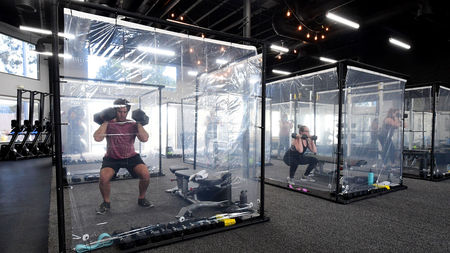
A gym in Redondo Beach, California, takes extreme measures to prevent COVID-19 transmission. A study in Norway suggests even with less stringent distancing, working out at the gym may be safe.
FREDERIC J. BROWN/AFP via Getty Images
Science’s COVID-19 reporting is supported by the Pulitzer Center.
Wondering whether it’s safe to go back to the gym? Norwegian gymgoers may have some good news for you. A study on the risk of coronavirus transmission in Oslo found that people who went to a gym were no more likely to get infected, or sick, than people who didn’t. Norway has reopened its gyms based on the tentative results, which were published as a preprint yesterday and still need to go through peer review.
But some epidemiologists aren’t so sure. It’s possible that no one was infected at those Oslo gyms because there were very few COVID-19 cases in the city when the study was done—not because working up a sweat on the treadmill or lifting weights in the midst of a pandemic is safe.
Related
So far, crucial decisions to reopen public spaces after lockdowns are being made on the basis of little evidence. Every child returning to school and every Zumba fan returning to class is taking part in a large, uncontrolled experiment. A much better approach is to carefully study the impact of each new step in reopening, argues Mette Kalager, a clinical epidemiologist at the University of Oslo and one of the lead scientists on the study.
Kalager and her colleagues worked with gyms in Oslo to recruit about 4000 participants—none of whom had been tested for COVID-19—in May and June. At that point, Norway had reported 8309 confirmed cases and 235 COVID-19–related deaths since February, with the peak of the nationwide outbreak hitting in early May.
Although gyms across Norway were still closed, half of the participants were given the opportunity to train in five gyms that opened specifically for the study and upheld rigid standards of hygiene and social distancing, such as cleaning the machines after each use and keeping visitors 2 meters apart. The only people gymgoers encountered were other study participants and gym staff. More than 80% of people in this group made it to the gym at least once in the 2-week study period, and nearly 40% went more than six times. The other half weren’t allowed to visit the gym, and went about their daily lives as usual. After about 2 weeks, both groups tested themselves for SARS-CoV-2 using polymerase chain reaction swab tests.
Nearly 80% of the participants sent in their tests. None of 1868 people in the control group tested positive, and only one of 1896 gymgoers did—but that person had not yet been to the gym and likely was infected elsewhere, the researchers report in a preprint posted to medRxiv. Kalager and colleagues also searched Norway’s comprehensive public medical records and found that none of the participants in either group had been admitted to a hospital with COVID-19–related complaints.
That doesn’t mean gyms are safe, says Darren Dahly, an epidemiologist at University College Cork. Over the weeks of the study, Oslo was reporting only a handful of new cases per day, with a maximum of 24 in 1 day. That means people in the study were already at very low risk, he says—possibly too low for a meaningful difference to be detected between the two groups.
Emily Smith, an epidemiologist at George Washington University, agrees. “There were zero sick people who went to the gym in this study,” she says. “We need to know what happens when people who are sick with COVID—but perhaps don’t yet have symptoms or have mild symptoms—go to the gym, take a spin class, and share a locker room with others.” Smith also points to the brief time period covered by the study: People who started to go to the gym a little later in the study period may have been exposed, but could have been tested too soon in the incubation period for the virus to be detectable.
Kalager agrees the results can’t determine whether it’s safe to go to the gym in places like Arizona “where the incidence of COVID-19 is much higher.” But in places with low numbers of new cases, “it’s safe,” she says.
Widespread publicity of the results without noting the caveats could be harmful, says Hilda Bastian, a former consumer health care advocate and a Ph.D. student at Bond University who studies evidence-based medicine. “The risk is that people think it means all gyms are safe, if there’s just some hygiene measures and a bit of social distancing,” she says.
But Bastian applauds the use of a clinical trial to study the safety of reopening. “Using trials to answer these kinds of questions is a good thing,” Dahly agrees. Every reopening is an experiment, he says. The question is “whether you’re going to learn from it or not.”
The next trial Kalager and her colleagues plan to run will compare infection risk at newly reopened gyms in Oslo that have more or less stringent hygiene and social distancing measures. With far higher numbers of attendees, she says, the trial will be able to offer stronger evidence on gyms’ safety and the success of hygiene measures.

